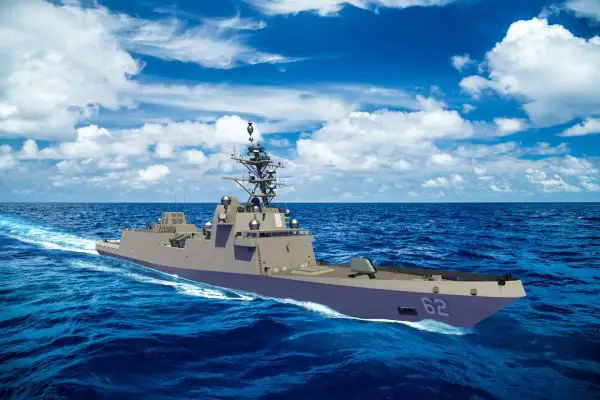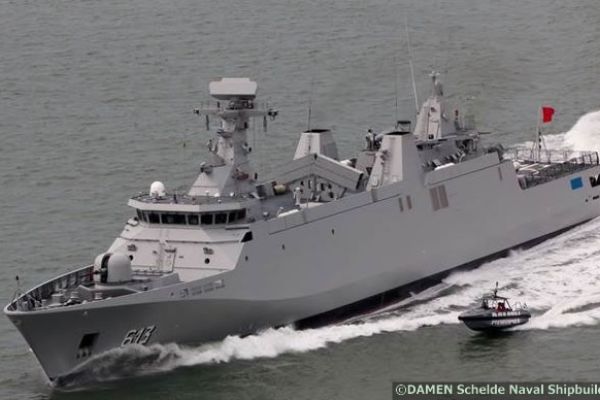Frigate.
FDI Frigate Belharra-class.

The FDI Frégate de Défense et d’Intervention (Defense and Intervention Frigate) is an advanced class of multi-role frigates developed by Naval Group, a French naval shipbuilder. Commissioned by the French Ministry of Armed Forces via the Direction Générale de l’Armement (DGA - French Armed Forces Procurement Agency), the FDI represents the latest evolution in surface combatants for both the French and Hellenic navies. The FDI is a compact but highly capable warship class, designed for operations in high-threat environments and equipped with cutting-edge digital, cyber, and combat systems.
Country users: France, Greece
Description
The FDI frigate, also known as the Belharra-class for export purposes, is a multi-mission, high-seas capable warship tailored for full-spectrum maritime operations. Developed by the French Company Naval Group, this class emerged from France's need for five new-generation frigates to complement the FREMM multi-purpose frigate and Horizon-class air-defence destroyer. The design prioritizes versatility, survivability, and digital supremacy, with the added distinction of being the first French frigate natively protected against cyber threats.
Development officially began in the mid-2010s, and the lead ship of the class, Amiral Ronarc’h, had its keel laid on 17 December 2021. She was launched on 7 November 2022 and commenced her first sea trials on 7 October 2024 from Lorient. Delivery to the French Navy is expected in 2025. The class is built at Naval Group's Lorient facility using advanced modular construction techniques and digital engineering platforms.
The Hellenic Navy joined the program in 2022 with a signed contract for three frigates—Kimon, Nearchos, and Formion—with an option for a fourth, Themistokles. These ships will be delivered between 2025 and 2026. A hallmark of the FDI design is its ability to operate in all warfare domains, including anti-air, anti-surface, anti-submarine, and asymmetric warfare, while also supporting the deployment of special forces and aerial systems. This makes the FDI one of the most versatile and modern surface combatants in its weight class.
The ships incorporate a unique digital core, supported by twin redundant data centers that enable rapid integration of new capabilities and resilience against cyberattacks. The Sea Fire radar, a fully digital AESA system, offers 360° coverage, enhancing both situational awareness and engagement capabilities. The ship's stealth profile, compact hull, and full suite of advanced sensors make it an agile yet heavily armed platform for blue-water operations or littoral engagements.
FDI Frigate variants:
- French Variant (FDI – French Navy): This version is tailored for global, multi-domain operations under France’s strategic doctrine. It features 16 Aster 15/30 missiles in Sylver A50 launchers, 8 Exocet MM40 Block 3C anti-ship missiles, a 76 mm main gun, MU90 torpedoes, and two Narwhal 20 mm remote weapon stations. It includes the Thales Sea Fire radar, SETIS 3.0 combat management system, and native cyber protection with dual data centers. Designed for autonomous missions and long-range deployments, this variant focuses on balanced, first-rate frigate performance in blue-water environments.
- Hellenic Variant (FDI HN – Greek Navy): Customized to Greek naval requirements, this variant enhances area air defense with 32 Aster 30 B1 missiles—double the French load—and incorporates RAM launchers for close-in protection. It retains the 76 mm gun, 8 Exocet MM40 Block 3C missiles, MU90 torpedoes, and CANTO countermeasures. The FDI HN includes Greek-specific software and electronics within its CMS and PSIM modules. Designed for the Aegean and Eastern Mediterranean, it emphasizes air and missile defense superiority and interoperability within NATO maritime forces.
Shiplist:
- Amiral Ronarc’h (D660) was built at DCNS Lorient, with keel laying on 17 December 2021, launched on 7 November 2022, and expected to be commissioned in 2025. She is currently undergoing sea trials.
- Amiral Louzeau (D661) began module fabrication with steel cut in July 2023. The ship is under construction and is scheduled for commissioning in 2027.
- Amiral Castex (D662) had its steel cut in October 2024, with commissioning estimated for 2028.
- Amiral Nomy (D663) has been ordered and is projected to enter service around 2031.
- Amiral Cabanier (D664) is also on order, with commissioning projected for 2032.
Hellenic Navy:
- HS Kimon (F-601) had its keel laid on 21 October 2022, launched on 28 September 2023 (technical launch) and 4 October 2023 (official ceremony). Commissioning is expected by late 2025.
- HS Nearchos (F-602) had its keel laid in late 2023 and was launched on 19 September 2024. She is undergoing fitting out, with delivery expected in late 2025.
- HS Formion (F-603) had its keel laid on 15 April 2024 and is scheduled for launch on 4 June 2025, with commissioning in early 2026.
- Themistokles (F-604/F-600) is currently under negotiation as a potential fourth frigate for the Hellenic Navy, with delivery potentially by late 2028.
Technical Data
-
Design
The FDI frigate is designed to offer maximum capability in a compact platform. With a full-load displacement of around 4,500 tons, they measure 122 meters in length and have a beam of 18 meters. The class features an innovative inverted bow design to enhance stability and seakeeping in rough seas while also minimizing radar signature. The internal architecture is modular and optimized for ease of access during maintenance or upgrades. The ship accommodates 125 crew members and can carry an additional 28 personnel for missions such as special forces deployment or helicopter detachment. The flight deck and hangar support a 10-ton class helicopter, such as the NH90 Caïman Marine, and an aerial drone, with capabilities for simultaneous operations.
-
Armament
The armament suite of the FDI is tailored for multi-domain operations. French Navy variants carry 16 Aster 15/30 surface-to-air missiles in Sylver A50 vertical launch systems. The Hellenic Navy variants are armed with 32 Aster 30 B1 missiles, providing enhanced air defense. Each ship is also equipped with eight MM40 Exocet Block 3C anti-ship missiles capable of engaging targets at ranges exceeding 200 kilometers.
The main gun is a 76 mm Super Rapid cannon mounted forward, used for surface threats and naval gunfire support. Two Narwhal 20 mm remote weapon systems provide close-range protection against fast boats or UAVs. The ASW suite includes four torpedo tubes launching MU90 Impact lightweight torpedoes. In addition, FDI HN frigates will feature Rolling Airframe Missiles (RAM) for point defense, a capability unique to the Greek variants.
Countermeasures include the CANTO anti-torpedo system, which is integrated with the SYLENA decoy launcher for high-fidelity defense against underwater threats.
-
Sensors, Electronics, and Decoys
The sensor and electronic warfare capabilities of the FDI are centered around the Thales Sea Fire radar. This AESA system with four fixed panels offers full 360° coverage, high-speed target tracking, and integration with the Aster missile suite for area air defense. Anti-submarine operations are enabled by a combination of the Kingklip Mark II hull-mounted sonar and the CAPTAS-4 compact variable-depth sonar.
The Panoramic Sensor and Intelligence Module (PSIM) consolidates electronic and radar sensors into a stealth-optimized superstructure. Electronic support and countermeasure roles are managed by the Thales SENTINEL suite, offering advanced detection and jamming of enemy emissions. Combat operations are coordinated through the SETIS 3.0 Combat Management System, which offers robust data fusion, multi-domain awareness, and seamless integration with allied forces under NATO standards.
Unique to the FDI is a dual redundant digital core, comprising two virtualized data centers that host the ship’s mission systems. This architecture allows for dynamic reconfiguration, rapid updates, and enhanced cybersecurity, making the FDI the first cyber-defended frigate class from France.
-
Engine
The FDI propulsion is provided by a Combined Diesel and Diesel (CODAD) system, producing up to 32 megawatts of power. This configuration propels the ship to a top speed of 27 knots and grants a range of 5,000 nautical miles at cruising speed. The design prioritizes acoustic discretion, vital for anti-submarine warfare, and endurance of up to 45 days. Twin controllable-pitch propellers offer maneuverability and redundancy, allowing the FDI to operate effectively in both open-ocean and littoral environments.
The FDI is thus a culmination of France's cutting-edge naval technology—highly adaptable, powerfully armed, and resilient against future digital and kinetic threats.
Specifications
-
Type
Multi-role first-rate frigate (classified as a destroyer by NATO)
-
Country users
France, Greece
-
Designer Country
France
-
Armament
16 or 32 Aster 15/30 surface-to-air missiles, 8 Exocet MM40 Block 3C anti-ship missiles, 76 mm naval gun, 2 Narwhal 20 mm remote weapon stations, 4 MU90 lightweight torpedoes, RAM launcher (Hellenic variant), CANTO anti-torpedo decoy system
-
Crew
125 personnel + 28 passengers
-
Engines
Combined Diesel and Diesel (CODAD), 32 MW total output
-
Onboard Equipment
Thales Sea Fire radar, Kingklip Mk II sonar, CAPTAS-4 towed sonar, SETIS 3.0 combat management system, SENTINEL electronic warfare suite, SYLENA decoy launchers, PSIM integrated mast, twin cyber-secure data centers
-
Speed
27 knots
-
Range
5,000 nautical miles at 15 knots
-
Dimensions
Length: 122 m; Beam: 18 m; Height: 33 m















































